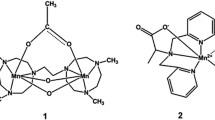Abstract
We investigated whether free radical scavengers and antioxidants inhibit the accumulation of platinum (Pt) in the cerebral cortex. Pt was detected in the cerebral cortex of mice afters administration of cisplatin and exposure to short-term hypoxia. When mice were treated with either allopurinol (20 mg/kg) or catalase (100 mg/kg) before cisplatin administration and low oxygen exposure, Pt was not detected in the cerebral cortex. However, Pt was detected in the cerebral cortex of mice pretreated with either a low dosage of allopurinol or heat-denatured catalase. Furthermore, Pt was detected in the cerebral cortex of mice preadministered vitamin C, vitamin E, or deferoxamine. Lipid peroxide levels in the cerebral cortex increased 10 min after the treatment of hypoxia, and peaked 30 min after the treatment. These results suggested that short-term hypoxia produces free radicals, which allows Pt to pass through the blood-brain barrier and accumulate in the cerebral cortex, and that the production of free radicals is reduced by the administration of either allopurinol or catalase, which prevents Pt from passing through the barrier.
Similar content being viewed by others

References
W. M. Pardridge, Recent advances in blood-brain barrier transport,Ann. Ver. Pharmacol. Toxicol. 28, 25–39 (1988).
S. I. Rapoport, M. Hori, and I. Klatzo, Reversible osmotic opening of the blood-brain barrier,Science 173, 1026–1028 (1971).
R. Suzuki, T. Yamaguchi, T. Kirino, F. Orzi, and I. Klatzo, The effects of 5-minute ischemia in mongolian gerbils: I. Blood-brain barrier, cerebral blood flow, and local cerebral glucose utilization changes,Acta Neuropathol. 60, 207–216 (1983).
N. Saito, C. Chang, K. Kawai, F. Joo, T. S. Nowak Jr., J. Ikeda, G. Nagashima, C. Ruetzler, J. Lohr, M. Spatz, and I. Klatzo, Role of neuroexcitation in development of blood-brain barrier and oedematous changes following cerebral ischaemia and traumatic brain injury.Acta Neurochir. Suppl. 51, 186–188 (1990).
A. Patt, R. B. Rutherford, W. H. Pearce, and J. E. Repine, Cerebral ischemia-reperfusion injury in the gerbil,J. Surg. Res. 42, 462–466 (1987).
T. Minami, M. Ichii, and Y. Okazaki, Detection of platinum in the brain of mice treated with cisplatin and subjected to short-term hypoxia.J. Pharm. Pharmacol. 48, 505–509 (1996).
C. Palmer, R. C. Vannucci, and J. Towfighis, Reduction of perinatal hypoxic-ischemic brain damage with allopurinol,Pediat. Res. 27, 332–336 (1990).
C. Palmer, J. Towfighi, R. L. Roberts, and D. F. Heitjan, Allopurinol administered after inducing hypoxia-ischemia reduces brain injury in 7-day-old rats,Pediat. Res. 33, 405–411 (1993).
M. Yamamoto, T. Shima, T. Uozumi, T. Sogabe, K. Yamada, and T. Kawasaki, A possible role of lipid peroxidation in cellular damages caused by cerebral ischemia and the protective effect of α-tocopherol administration.Stroke 14, 977–982 (1983).
E. S. Flamm, H. B. Demopoulos, M. L. Seligman, R. G. Poser, and J. Ransohoff, Free radicals in cerebral ischemia,Stroke 9, 445–447 (1978).
W. H. Gispen, P. Schotman, and E. R. De Kloet, Brain RNA and hypophysectomy; A topographical study,Neuroendocrinol 9, 285–296 (1972).
T. Minami, M. Ichii, and Y. Okazaki, Comparison of three different methods for measurement at tissue platinum level,Biol. Trace Elem. Res. 48, 37–44 (1995).
K. Yagi, A simple fluorometric assay for lipoperoxide in blood plasma,Biochem. Med. 15, 212–216 (1976).
J. M. Hill, E. Loeb, A. Maclellan, M. O. Hill, A. Khan, and J. J. King, Clinical studies of platinum coordination compounds in the treatment of various malignant diseases,Cancer Chemother. Rep. 59, 647–659 (1975).
H. R. Brady, M. L. Zeidel, B. C. Kone, G. Giebisch, and S. R. Ullans, Differential actions of cisplatin on renal proximal tubule and inner medullary collecting duct cells,J. Pharm. Exper. Ther. 265, 1421–1428 (1993).
S. W. Thompson, L. E. Davis, M. Kornfeld, R. D. Hilgers, and J. C. Standefer, Cisplatin neuropathy. Clinical, electrophysiologic, morphologic, and toxicologic studies,Cancer 54, 1269–1275 (1984).
R. W. Gregg, J. M. Molepo, V. J. A. Monpetit, N. Z. Mikael, D. Redmonds, M. Gadia, and D. J. Stewart, Cisplatin neurotoxicity: The relationship between dosage, time, and platinum concentration in neurologic tissues, and morphologic evidence of toxicity,J. Clin. Oncol. 10, 795–803 (1992).
J. Z. Ginos, A. J. L. Cooper, V. Dhawan, J. C. K. Lai, S. C. Strother, N. Alcock, and D. A. Rotternberg, [13N] Cisplatin PET to assess pharmacokinetics of intra-arterial versus intravenous chemotherapy for malignant brain tumors,J. Nucl. Med. 28, 1844–1852 (1987).
J. T. Coyle and P. Puttfaarcken, Oxidative stress, glutamate, and neurodegenerative disorders,Science 262, 689–695 (1993).
J. R. Zhang, P. K. Andrus, and E. D. Hall, Age-related regional changes in hydroxyl radical stress and antioxidants in gerbil brain,J. Neurochems. 61, 1640–1647 (1993).
A. J. L. Cooper, W. A. Pulsinelli, and T. E. Duffy, Glutathione and ascorbate during ischemia and postischemic reperfusion in rat brain,J. Neurochem. 35, 1242–1245 (1980).
T. K. Aalto and K. O. Raivio, Nucleotide depletion to reactive oxygen metabolites in endothelial cells: Effects of antioxidants and 3-aminobenzamide,Pediatr. Res. 34, 572–576 (1993).
Author information
Authors and Affiliations
Rights and permissions
About this article
Cite this article
Minami, T., Ichii, M., Okazaki, J. et al. Free radical scavengers suppress the accumulation of platinum in the cerebral cortex. Biol Trace Elem Res 55, 1–7 (1996). https://doi.org/10.1007/BF02784163
Received:
Accepted:
Issue Date:
DOI: https://doi.org/10.1007/BF02784163



